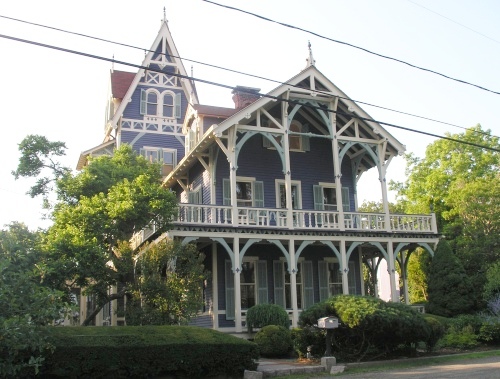Stick style
The Stick style was an American architectural style that was prevalent between around 1860 and 1890.
The most distinctive stylistic element of the Stick style is the decorative stickwork or bands of wood trim applied horizontally, vertically or diagonally to the exterior wall surfaces. A similar pattern of decorative wood trim appears in the trusses of the gables and across gables and on the porch braces.
The Stick style is considered to be a transitional style, with decorative details similar to the preceding Gothic Revival style, and a shape and form closely related to the following Queen Anne style. All three styles are inspired by Medieval English building tradition and therefore, share some common features.
Unlike the Gothic Revival style, the Stick style treats wall surfaces, not just doorways, cornices, windows and porches as decorative elements.
Like other Picturesque styles, the Stick style was promoted by the pattern books of Andrew Jackson Downing in the mid-1800s.
The exterior stickwork was considered to be display structural honesty by showing the supportive wooden understructure on the outside. Since the stickwork on the walls was purely decorative rather than structurally relevant, such an argument for the greater integrity of form of this style seems somewhat unfounded.
The Stick style was never as popular and wide spread as the somewhat later Queen Anne style which appears in various forms all over the United States.
Some of the key identifiable features of the Stick style are as follows:
- Steeply pitched gable roof.
- Cross gables.
- Decorative trusses at gable peak.
- Overhanging eaves with exposed rafters.
- Wood exterior walls with clapboards.
- Horizontal, vertical or diagonal decorative wood trim - stickwork.
- Porches with diagonal or curved braces.
- Towers.
--Pennsylvania Historical and Museum Commission
[edit] Find out more
[edit] Related articles on Designing Buildings Wiki
IHBC NewsBlog
Images from inside a Grade II listed hotel show the scale of its collapse
The Corbett Arms in Tywyn has fallen into serious disrepair.
Old Sarum fire in listed (& disputed) WW1 Hangar - Wiltshire Council has sought legal advice after fire engulfed a listed First World War hangar that was embroiled in a lengthy planning dispute.
UK Antarctic Heritage Trust launches ‘Virtual Visit’ website area
The Trust calls on people to 'Immerse yourself in our heritage – Making Antarctica Accessible'
Southend Council pledge to force Kursaal owners to maintain building
The Council has pledged to use ‘every tool in the toolbox’ if urgent repairs are not carried out.
HE’s Research Magazine publishes a major study of the heritage of England’s suburbs
The article traces the long evolution of an internal programme to research 200 years of suburban growth
IHBC Context 183 Wellbeing and Heritage published
The issue explores issues at the intersection of heritage and wellbeing.
SAVE celebrates 50 years of campaigning 1975-2025
SAVE Britain’s Heritage has announced events across the country to celebrate bringing new life to remarkable buildings.
IHBC Annual School 2025 - Shrewsbury 12-14 June
Themed Heritage in Context – Value: Plan: Change, join in-person or online.
200th Anniversary Celebration of the Modern Railway Planned
The Stockton & Darlington Railway opened on September 27, 1825.
Competence Framework Launched for Sustainability in the Built Environment
The Construction Industry Council (CIC) and the Edge have jointly published the framework.















